タイ王国ロイヤル・ソサエティ一行の来訪Visit by members of the Royal Society of Thailand
November 15, 2017
[:ja]11月7日、タイ王国ロイヤル・ソサエティより、会長のSobha Spielmann博士を筆頭に、ロイヤル・ソサエティを構成する3つのアカデミーの代表者たち及び同ソサエティ事務局の代表者たち計19名から成る派遣団が本学を訪問しました。本学からは澤和樹学長、岡本美津子副学長(国際・ダイバーシティ推進担当)、O JUN教授(美術学部)が一行をお迎えしました。
はじめに、澤学長より、タイ王国ロイヤル・ソサエティ一行の来学を心より歓迎する旨の挨拶があり、今後のタイと藝大のより一層の繋がりに対する期待が述べられました。

一行を歓迎する澤学長
Sobha Spielmann会長からは、歓迎に対する感謝が述べられた後、タイ王国ロイヤル・ソサエティは90年の歴史を持ち、モラル・政治アカデミー、科学アカデミー、芸術アカデミーの3つのアカデミーから構成されていることが紹介されました。また、芸術アカデミーのSurapone Virulrak博士からは、タイ王国ロイヤル・ソサエティの芸術分野には大きく3つの部門(文学、建築、ファインアート)があり、芸術アカデミーの業績を国民に広めるため、書物の発行、Webサイトやラジオの活用のほか、地方でのセミナー実施などに取り組んでいることが紹介されました。
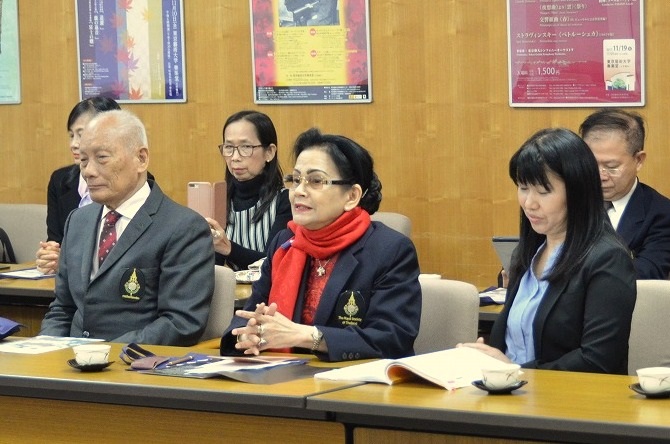
タイ王国ロイヤル・ソサエティについて説明するSobha Spielmann会長
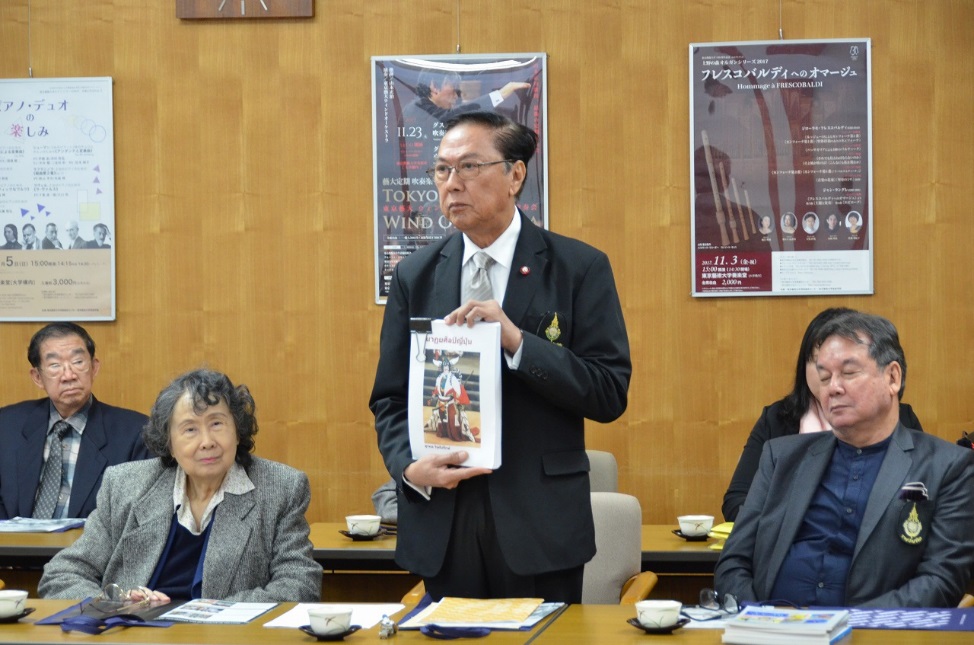
日本の歌舞伎、文学、能などについての研究成果を紹介するSurapone Virulrak博士
続いて、岡本副学長より、本学は2学部4研究科から成る総合芸術大学であることが紹介された後、タイと本学との交流の実績として、2016年12月9日~11日に行われたシラパコーン大学でのワークショップ「アニメーションブートキャンプ」の様子が写真と共に紹介されました。初めてにも関わらずクオリティーの高いアニメーションを制作したタイの学生たちは優秀かつ熱心であったと岡本副学長が振り返ると、一行はシラパコーン大学と本学の間で意義深い交流が行われていることに感心した様子でした。
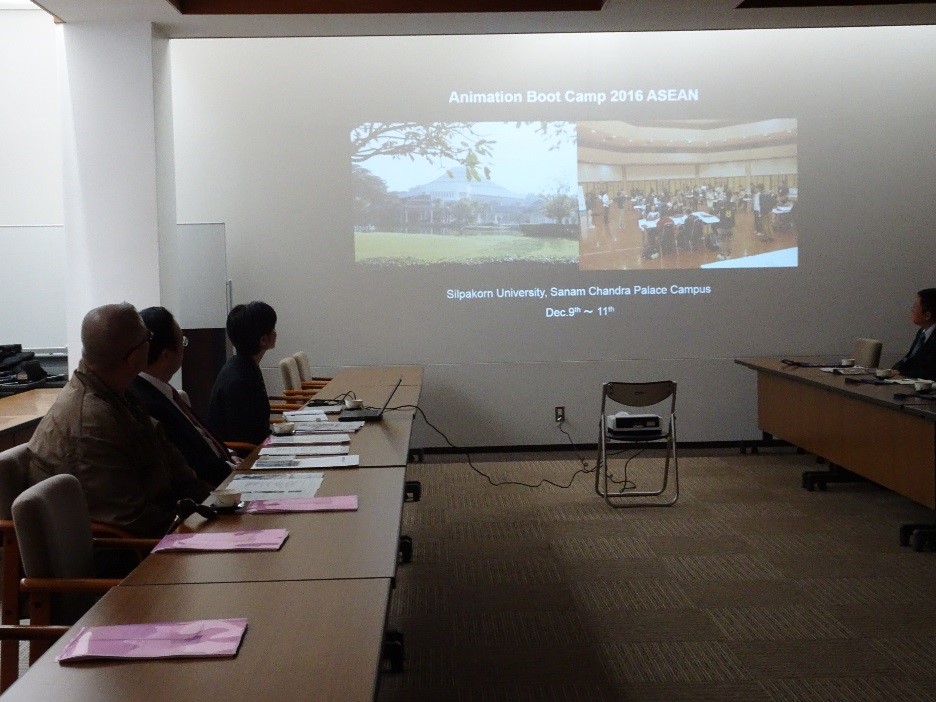
「アニメーションブートキャンプ」の紹介をする岡本副学長
O JUN教授からは、シラパコーン大学と本学の美術学部は国際交流協定校の関係にあり、現在は絵画科油画専攻、工芸科、デザイン科が交換留学を行っていると紹介された後、芸術を介して両校の親睦を深めていきたいとの期待が述べられました。
 シラパコーン大学との国際交流協定について説明するO JUN教授
シラパコーン大学との国際交流協定について説明するO JUN教授
会談後、一行は東京藝術大学COI拠点「産学官連携棟(Arts & Science LAB.)」2階コンテンツ開発研究工房にて高精細に複製された「クローン文化財」を視察しました。平諭一郎特任准教授(社会連携センター)は「クローン文化財」であるからこそ作品に触れることができることを説明するとともに、浮世絵やフェルメールやゴッホなどの作品の「クローン文化財」を紹介し、実際に手で触れていただき、「クローン文化財」を体感していただきました。また、平特任准教授より、2001年にタリバンの手で破壊され、最先端のデジタル技術と東京藝大のアナログ技術を駆使して復元されたバーミヤン東大仏天井壁画「天翔る太陽神」がG7伊勢志摩サミットで展示されたことについても解説があり、一行の注目を集めていました。
 「クローン文化財」に触れる一行
「クローン文化財」に触れる一行
その後、一行は大学美術館へ移動し、「皇室の彩 百年前の文化プロジェクト」展(会期:2017年10月28日-11月26日)を鑑賞しました。皇室とゆかりのある作品や制作資料など貴重な展示の数々を、特にSurapone Virulrak博士をはじめとした芸術分野のメンバーは真剣に鑑賞していました。また、黒川廣子教授(大学美術館)による皇室献上品制作と本学の前身である東京美術学校との関係や作品についての解説に一行は熱心に耳を傾け、時折技法などについて質問するなど、日本の文化や芸術への理解を深めました。
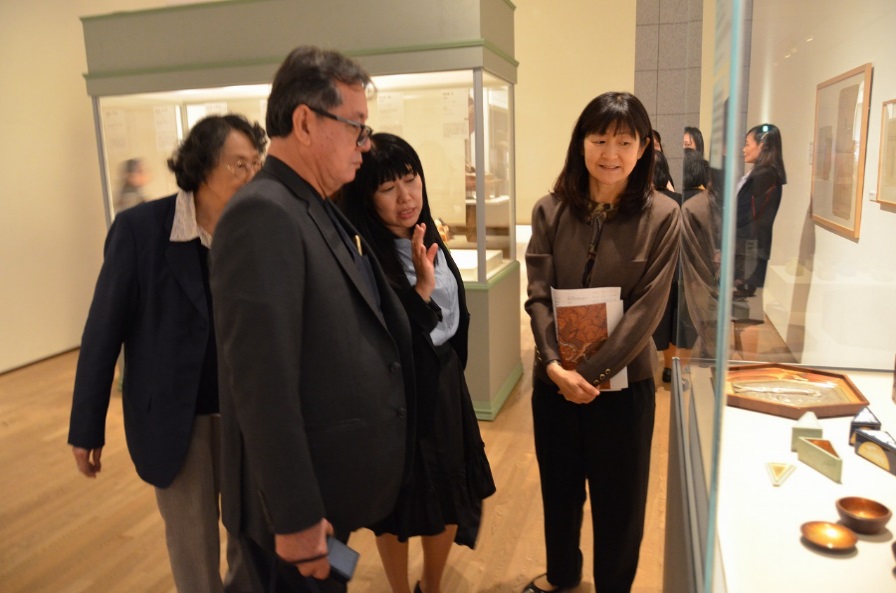 黒川教授(右)の解説を聞く一行(左から)Srisurang Poolthupya 氏、Viboon Leesuwan氏
黒川教授(右)の解説を聞く一行(左から)Srisurang Poolthupya 氏、Viboon Leesuwan氏
今回の訪問を通じ、日本の芸術文化や、本学の取り組みについて理解を深めた一行は、今後のタイと本学との一層の交流の可能性への期待とともに、大学を後にされました。
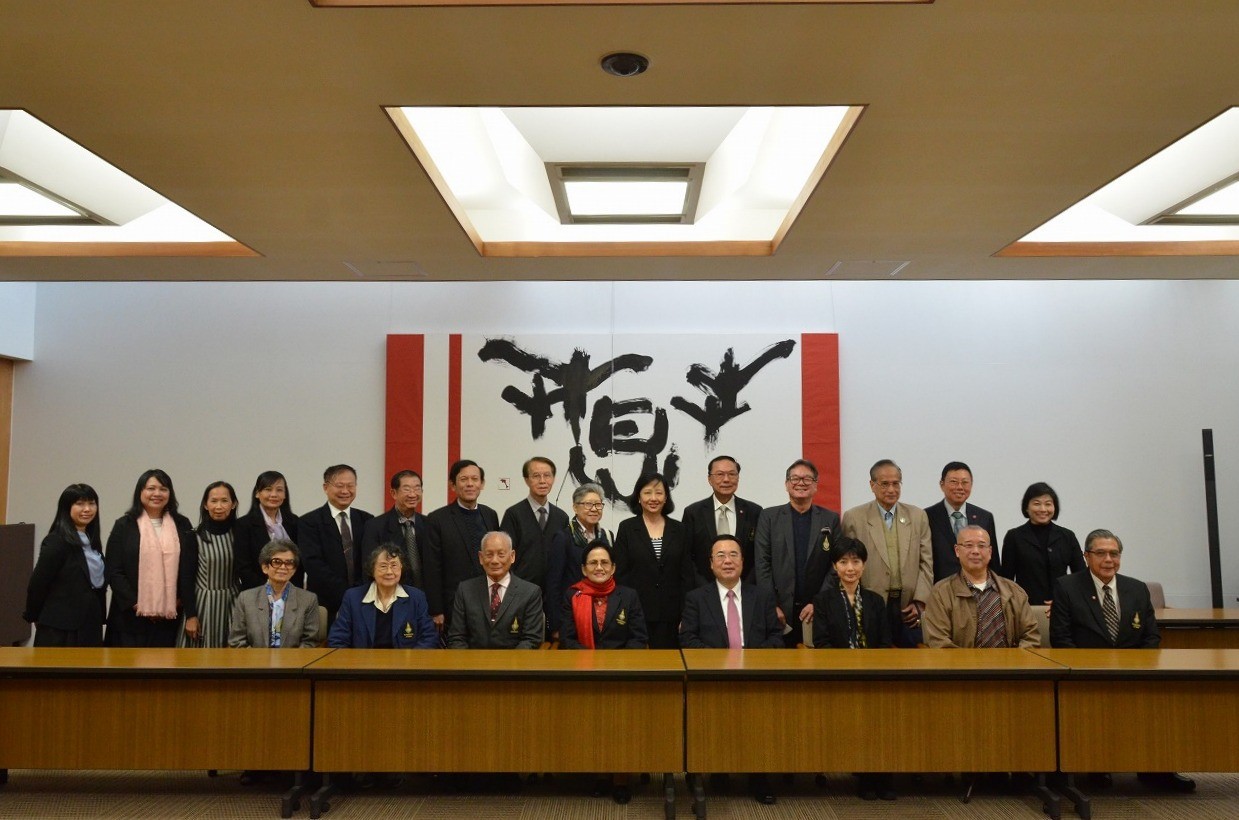
[:]
On November 7, 2017, a delegation from the Royal Society of Thailand headed by President Sobha Spielmann visited Tokyo University of the Arts (Tokyo Geidai). A total of 19 representatives from the three academies of the Royal Society of Thailand and the Office of the Royal Society of Thailand were welcomed by President Kazuki Sawa, President Mitsuko Okamoto, Vice President of International Affairs and Campus Diversity Professor), and Professor O Jun of Faculty of Fine Arts.
President Sawa gave the guests a warm welcome, saying that he would expect more collaboration to happen between Tokyo Geidai and Thailand.

President Sawa welcomed the Thai delegation
After showing her appreciation for the welcome her delegation received, President Spielmann introduced that the Royal Society of Thailand, with a ninety–year history, consists of three academies of Moral and Political Science, Sciences, and Arts. Dr. Surapone Virulrak of Academy of Arts added that his academy, with three major sections of Arts of literature, Architectural arts, and Fine Arts, has been working to deliver its academic achievements to the people of Thailand through various means such as publication, website and radio, and seminars in local regions.

President Spielmann explained the Royal Society of Thailand

Dr. Surapone Virulrak introduced his academy’s research outcomes on Japanese kabuki, literature, and Noh
Following the introduction of Tokyo Geidai as a comprehensive university of the arts with two undergraduate faculties and four graduate schools, Vice President Okamoto spoke about and showed pictures of “Animation Boot Camp”, a workshop that was held at Silpakorn University from Decamber 9 to 11, 2016, as an example of our collaborative undertakings with Thailand. Recalling that the participating Thai students were good and hardworking, she said they produced quality works for the first try. The guests looked impressed to know that the two universities had the significant collaborative project.
 Vice President Okamoto introduced “Animation Boot Camp”
Vice President Okamoto introduced “Animation Boot Camp”
Referring to the partnership agreement with Silpakorn University, under which the oil painting, craft, and designs departments at Tokyo Geidai have sent and received exchange students, Professor O Jun said that he would hope to promote friendship between the two universities through the arts.
 Professor O Jun talked about the partnership agreement with Silpakorn University
Professor O Jun talked about the partnership agreement with Silpakorn University
After the meeting, the Thai guests visited the Arts & Science LAB. to see the displays of high-definition “clone cultural properties” that had been reproduced in the laboratory on the second floor of the building. Project Associate Professor Yuichiro Taira explained that such “clone cultural properties” can be touched as they are meant for it, and had the guests actually touch an ukiyo-e print and a painting by Vincent van Gough to physically experience them. He then talked about the mural painting on the ceiling of the East Great Buddha in Bamyan, Afghanistan, which was destroyed by Taliban in 2001 but has been restored though the perfect combination of the latest digital technology and hand work by Tokyo Geidai’s artists. The guests seemed very much intrigued when were told that the mural painting was exhibited at the G7 Ise-Shima Summit in 2016.
 The guests felt a “clone cultural property” with their hands
The guests felt a “clone cultural property” with their hands
Later, they moved to the University Art Museum to see the special exhibition “Art Treasures of the Imperial Court” at the University Art Museum (Open: Oct 29 -Nov 26, 2017). President Spielmann and other guests were keenly looking at a variety of valuable art treasures and the reference materials related to the Imperial Family of Japan. They were also attentively listening to the detailed explanation by Professor Hiroko Kurokawa of the University Art Museum about the exhibits, and how and why they were made as items presented to the Imperial Court at Tokyo Fine Arts School, a predecessor of Tokyo Geidai. They occasionally asked questions such as about the techniques, deepening their knowledge about Japanese art and culture.
 The guests were listening to Prof.Kurokawa
The guests were listening to Prof.Kurokawa
(From left: Mrs. Srisurang Poolthupya and Mr. Viboon Leesuwan )
With increased understanding of Japanese art and culture, and various projects at Tokyo Geidai, the guests left the campus, expecting further potential development of collaboration between their country and Tokyo Geidai.



